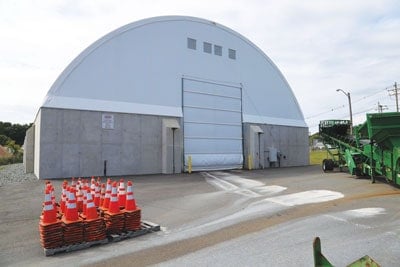Fabric structures have low initial investment costs compared to traditional buildings, and they are durable enough to withstand the harsh environments while saving money and preventing workflow interruptions for waste management facilities.
By Nicole Pulyado
Facility design for waste and recycling businesses is often geared towards increasing productivity. For this goal to be achieved it is important to take a step back and consider the fundamentals of site planning. While elements such as layout and organization are critical to consider in the later planning stages, building materials and structures should be considered much earlier in the design process. Waste and recycling sites can guarantee effective design by planning their facilities from the ground up, rather than skipping initial planning phases that create the foundation for success.
Reliable Structures
Durable building solutions are necessary to withstand the harsh environments of waste and recycling facilities. Businesses and municipalities that handle the processing of hazardous materials should be especially cognizant of what they use to store waste and recyclables. Investing in a reliable structure that can withstand these conditions will save businesses on time and money in the long run. This will not only ensure structural longevity, but it will also prevent premature repairs and replacements that can halt operations and cut profits. Conversely, if a site decides to cut corners and obtain a structure of lesser quality for a cheaper price, they can end up spending two to three times as much on recurring maintenance costs.
Corrosion-Resistance
So, what should facilities look for when trying to secure the most durable buildings possible for their site? First and foremost, any building used for a waste or recycling business should feature corrosion-resistance. Fabric structures are perhaps the most common choice for building solutions that can withstand such tough conditions. Users should opt for steel building frames that are triple galvanized to prevent premature wear and corrosion. This type of structural integrity ensures buildings will last for years to come, even when housing corrosive waste and other materials.
Although fabric structures and other innovative building solutions are great for preventing excessive wear over time, many users worry about their overall durability in comparison to traditional buildings. Not only are fabric structures ideal for withstanding harsh conditions, but they also offer enough durability to be constructed, relocated and expanded with ease while maintaining complete reliability.

Strong Foundations
Foundation solutions, such as helical anchors, secure fabric buildings by drilling directly into the ground and remaining there for as long as users would like, making them a secure permanent foundation option. The anchors can also be undrilled when users desire, allowing structures to be relocated quickly and efficiently. Innovative building solutions are the only option on the market that sustain full strength and structural integrity after relocating from one site to another.
Building covers should also incorporate the same sturdiness as the framing and foundation if users want to maximize their investment. Building materials such as wood, brick and glass are impractical for many waste management facilities. These options are lacking terms of durability and affordability, so they are not the best options. Fabric-clad buildings are an affordable solution that withstand the test of time, offering high tensile strength and flexibility, while encouraging airflow to alleviate lingering smells. Hybrid buildings are another sustainable option that combine the benefits of fabric and metal buildings to create a cohesive structure that is made to last.
Use Customer Feedback
When shopping around for information on potential buildings, business owners should also look at others using similar structures. Customer testimonials are an easy way to get a genuine review of a particular building and how it is performing on other sites. It may also be beneficial to make an in-person visit to a business using a fabric structure. New customers can gain years of insight from speaking with long-term users of innovative buildings and seeing how the structures function in use. Generally, if a company is unable to produce long time users and repeat customers of their product, it could be a potential sign that you will not find longevity in their buildings either.
Warranties
In addition to seeing a portfolio of past clients, potential buyers should also look for warranties to accompany their purchase. A 20-year warranty is standard for innovative structures, ensuring businesses are not making blind investments for their facility. Occasionally, fabric buildings will be accompanied by a 30-year warranty if they offer the utmost durability and strength. Regardless, it is important for business owners to receive the assurance of a warranty with their new building, so they know the structure has a long life ahead.
Prevent Workflow Interruption
Incorporating these features into a fabric structure will ensure waste management sites are able to use their buildings for decades to come. Fabric structures have low initial investment costs compared to traditional buildings, and they are durable enough to withstand the harsh environments. Users will also avoid costly repairs and premature replacement when purchasing a high-quality structure, saving money and preventing workflow interruptions for waste management facilities. | WA
Nicole Pulyado is a PR and Digital Content Specialist with ClearSpan Structures (South Windsor, CT), which specializes in building solutions for the waste and recycling industry. For more information, call (866) 643-1010 or e-mail [email protected].
You may also like:
Exploring the Versatility of Fabric Structures for Waste Management
The Importance of a Site-Specific Review for Fabric Structures
